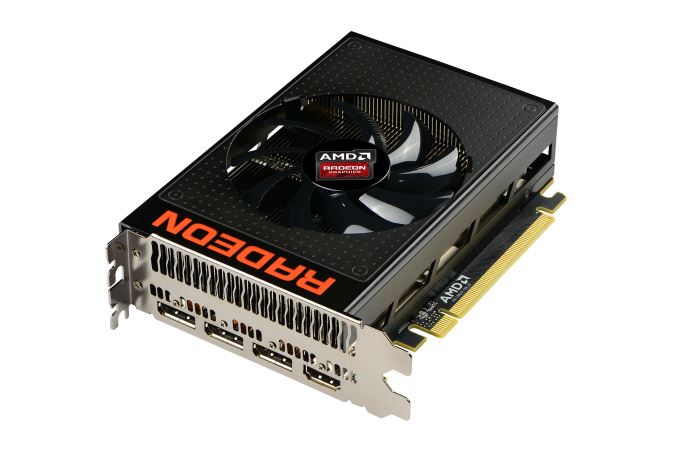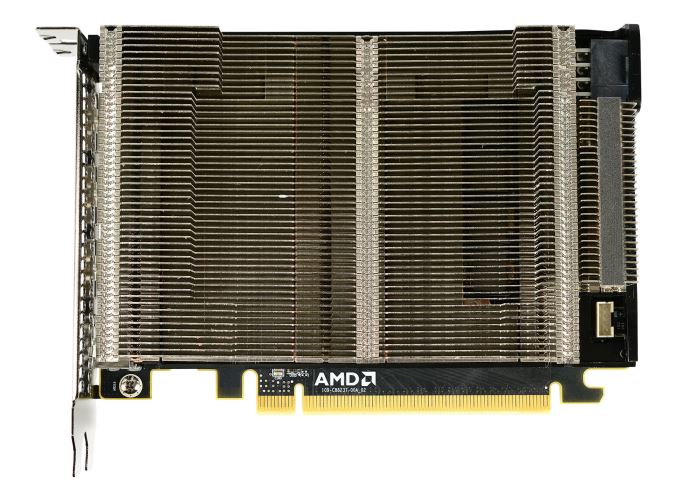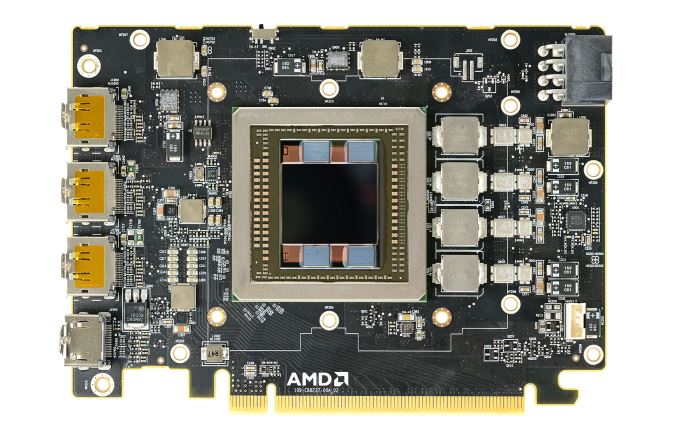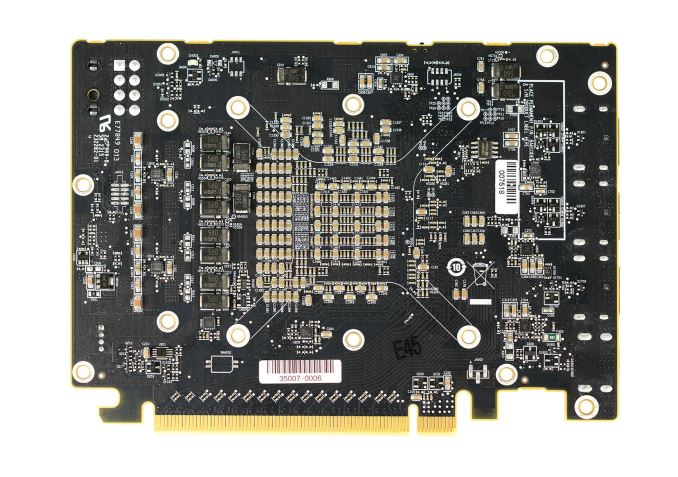The AMD Radeon R9 Nano Review: The Power of Size
by Ryan Smith on September 10, 2015 8:00 AM ESTMeet The Radeon R9 Nano
6 inch video cards are by no means a new thing in the GPU space, however these are traditionally lower-end products that need neither a large cooler nor an extensive power delivery system. As a result the R9 Nano is something of an interesting aberration, packing a lot more power and a lot more technology into half a foot of video card than what we normally see.
Starting as always from the top, the R9 Nano measures 6” long, which is actually a bit shorter than the full length the Mini-ITX standard allows. Responsibility for cooling the card falls to the R9 Nano’s new open air cooler, an aggressive design that has been specifically tailored to allow the card to effectively dissipate 175W of heat in such a small space.
The overall design of the R9 Nano’s cooler is best described as a combination open-air and half-blower hybrid. The design is technically open-air, employing a single axial fan to cool the card. However with only a single fan AMD has been able to align the heatsink fins horizontally and then place the fan in the center of the heatsink. The end result is that roughly half of the heat produced by the card is vented outside of the case, similar to a full blower, while the other half of the heat is vented back into the case. This reduces (though doesn’t eliminate) the amount of hot air being recycled by the card.
The heatsink itself is composed of aluminum and runs virtually the entire length of the card. This is technical a two-piece heatsink, with the primary heatsink composing the bulk of the card, while a much smaller secondary heatsink it found towards the far end of the card and mounted on top of a heatpipe.
Drilling down, we find that the primary heatsink is fed by a combination vapor chamber and heatpipe design. A copper vapor chamber serves to draw heat away from the Fiji GPU and HBM stacks, and then heatpipes are used to better distribute heat to the rest of the heatsink. The use of a vapor chamber in the R9 Nano makes a lot of sense given the fact that vapor chambers are traditionally the most efficient heatsink base type, however the R9 Nano is also unique in that we typically don’t see vapor chambers and heatpipes used together. Other designs such as the high-end GeForce series use a single large vapor chamber across the entire heatsink base, so among reference cards at least the R9 Nano stands alone in this respect. In this case given AMD’s design goals for size and noise, a vapor chamber will play a big part in helping the small card effectively and quietly dissipate 175W.
As for the physical PCB itself, as we can see AMD made it a relatively packed card in order to get the R9 Nano down to 6 inches. Compared to the R9 Fury X reference board, the biggest change here is that AMD has removed a fair bit of power circuitry to save space. By our count there are 4 VRM phases to feed the Fiji GPU, as opposed to the 6 found on R9 Fury X. Power delivery is handled by a single 8-pin PCIe power socket, which is becoming increasingly common, replacing the 2x 6-pin setup for 150W-225W cards.
Meanwhile to further shrink the overall PCB footprint, AMD has moved some of the remaining power delivery circuitry to the back of the card. The front of the card still contains the inductors and heat-sensitive MOSFETs, while a number of capacitors are on the rear of the card (and is why you won’t find a backplate).
Finally, for display I/O R9 Nano is unchanged from R9 Fury X. This means we’re looking at a DVI-free design, with 3x DisplayPort 1.2 and 1x HDMI 1.4 port all along a single row of the I/O bracket. Buyers looking to put together HTPCs will want to be especially mindful of the HDMI 1.4 port; while it's not necessarily a deal-breaker, it does mean that the R9 Nano can't fully drive 4Kp60 TVs, which are slowly but surely becoming more common.
Overall AMD is rather confident in their design for the R9 Nano. The heatsink is built to efficiently dissipate more heat than the 175W the card requires (despite the small size), and as a result we never see the R9 Nano thermally throttle under normal operation. The card’s thermal throttle point is 85C, and in our testing the card never passed 75C, exactly as AMD promised us. What ends up limiting the R9 Nano’s performance then is exactly as expected: the power throttling.
















284 Comments
View All Comments
Communism - Thursday, September 10, 2015 - link
The real sad part is that you could just take a 980GTX and overclock it the requisite amount to make it equal in performance to the Fury Nano, as Nvidia's Maxwell has no end-user voltage controls, meaning the extra clockspeed would increase power consumption only linearly.palindrome - Thursday, September 10, 2015 - link
Once again, the Fury Nano is competing against the 970 GTX Mini, not the 980 GTX, which is beats handily.palindrome - Thursday, September 10, 2015 - link
The Fury Nano is competing against the 970 GTX Mini, not the 980 GTX, which is beats handily.medi03 - Friday, September 11, 2015 - link
If you read the review you'd know it is 5% faster than 980.SeanJ76 - Thursday, September 10, 2015 - link
Why would anyone pay $100 more than 980GTX for less performance?? Doesn't make much sense does it?palindrome - Thursday, September 10, 2015 - link
Can you link me to where I can buy a 980 GTX the size of the Fury Nano?takeship - Thursday, September 10, 2015 - link
Can you point me to a single ITX case that has can both 1: take an ATX power supply, 2: will not also take a GTX980?meacupla - Thursday, September 10, 2015 - link
Lian-Li PC-Q21, PC-Q33On the other hand, Silverstone makes mITX cases that use SFX PSUs, but can still fit a 268mm (10.5in) long card in a 10.5L case (SG-13), or a 13" long card in an 11L case (RVZ02/ML08).
Interesting thing to note about RVZ02/ML08 is that you can trade graphics card length for an extra 3.5" HDD. http://silverstonetek.com/product.php?pid=607&...
palindrome - Thursday, September 10, 2015 - link
What about boutique PC builders that use custom case designs? Steam PCs and similar devices are trying to get smaller and smaller, this is yet another step toward that.This is a niche product, you seem to be forgetting that fact.
RafaelHerschel - Thursday, September 10, 2015 - link
There are quite a few cases but the Cooltek Coolcube comes to mind. The ASUS GTX970-DCMOC-4GD5 is perhaps a more sensible option, but the AMD card is tempting. The Coolcube isn't just small, it also has convenient dimensions.